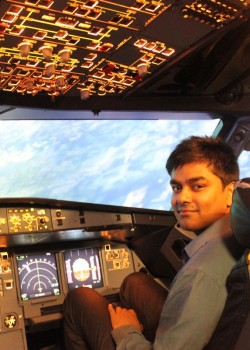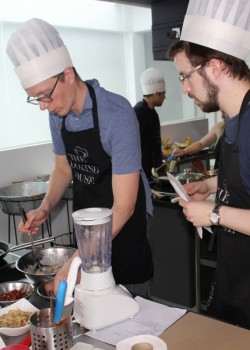
Asper MBA students ready to present in Malaysia
Going Global: Asper MBAs Experience Malaysia
In today’s world of international business, experience matters. Programs like the Asper MBA understand this – which is why they offer students opportunities to gain applied, international business experience before they graduate.
In April 2016, a group of 18 students from the Asper MBA program traveled to Kuala Lumpur, Malaysia in pursuit of exactly this kind of experience. There, they had the opportunity to learn more about the emerging South Asian market, and to work directly with Malaysian companies by proposing and implementing business strategies.
“The trip was a powerful personal and professional experience,” says second-year MBA student Matt Schaubroeck. “It allowed all of us to better understand not only the way business operates on the other side of the world, but how to apply the skills we learned in the classroom in an engaging and valuable way.”
Learning Far Beyond the Classroom
The trip was a key component of the International Business Trip course, a strategy capstone course for MBA students pursuing a specialization in International and Emerging Markets. The course challenges students to work directly with a client for ten weeks as part of a student consulting team.
“The company outlines a live problem or issue they are trying to solve, and the goal of the course is to develop a solution to the problem that can be incorporated to meet that client’s specific needs,” says Stuart Henrickson, the course’s instructor and the I.H. Asper Executive Director of Entrepreneurship at the Stu Clark Centre for Entrepreneurship.
Henrickson, who is intimately familiar with the Malaysian market, offered additional insight and resources to help each group provide the best possible deliverable to their Malaysian contacts. Each student group benefited enormously from the guidance of mentors from the previous year’s international trip to Dubai – and quickly discovered the unique challenges of overseas collaboration.
“The 13-hour time difference made for some interesting meeting times,” says Schaubroeck. “Our group had more than one Skype call with our Malaysian contact at 10:00 p.m., so it was necessary to readjust our internal clocks before even getting on a plane.”
Over the course of 10 weeks, each group worked to prepare a full business case and presentation. Once everything was ready, students packed their bags and headed off to the southern hemisphere, arriving in Malaysia in late April.
Kuala Lumpur
“The best way to first get to know a city like Kuala Lumpur is to see it from the top down,” says Amy Briscoe, Program Coordinator of the Stu Clark Centre. A trip up to the 85th floor viewing platform of the Petronas Twin Towers proved to be the ideal perch to take in the city. The largest freestanding twin towers in the world, the Petronas are a sight to behold – from outside as well as within. From there, the students developed a quick appreciation of the size and magnitude of this bustling south Asian metropolis.
The first of the four presentations took place at the Sepang International Circuit, the first dedicated F1 racetrack in the world. The class had the opportunity to tour the track and grandstands, including the VIP section where the Malaysian royal family takes in the annual race event. Sepang Circuit plays host to an annual F1 Grand Prix race, as well as MotoGP – a high-speed motorcycle race where competitors have reached speeds of up to 329.6 km/h. The class presentation to Sepang Circuit focused on diversifying its revenue models, including the creation of new entertainment and training centres to draw a regular stream of customers into the facility year-round
Students also presented at CAE, where flight teams for Air Asia go through a rigorous training program. The presentation focused on creating a handover process for the sales and customer service teams that created greater efficiencies within their internal systems. Afterwards, the class had the opportunity to experience the flight training school, including a personal beauty tip and etiquette workshop for flight attendants, evacuation drills, and a practical test on a real flight simulator, where (thankfully) no crashes were recorded by any Asper MBA student.
The presentations continued at Royal Selangor, where some of the world’s highest-caliber pewter manufacturing takes place. The MBA team presented an in-depth global market expansion list to the company, then toured the facility’s creative workshop and foundry. Some students had the opportunity to try their hands at pewter-crafting, while others were content to watch trained craftspeople turn the material into exquisite works of art.
The final course presentation took place at Smart Reader, a language-teaching company with over 450 franchises in Malaysia and beyond. The presentation focused on outlining the company’s international strategic market entry strategy, as well as the creation of a business plan for the company to adopt.
Understanding Malaysia
Although students spent much of the trip preparing and presenting to companies, they had plenty of time to gain an on-the-ground overview of Malaysia’s history, culture, and culinary scene.
Malaysia is famous for its spicy international flavours, which draw heavy inspiration from Indian and Chinese food. Members of the class even tried cooking a traditional nasi lemak – Malaysia’s unofficial national dish – in an Iron Chef-inspired competition at The Cooking House. Each team had only 90 minutes to create a sumptuous meal.
Malaysia’s lush ecosystem introduced students to the rainforest and the region’s unique flora and fauna. At the Forestry Research Institute of Malaysia, students took a trek through the world’s largest man-made rain forest.
The class also experienced Malaysia’s multicultural history firsthand over the course of the week. They visited both the 17,000-capacity Federal Territory Mosque and the Batu Caves, which are home to a Hindu shrine to Lord Murugani.
At a dinner event attended by some of Kuala Lumpur’s top lifestyle bloggers, students joined in a traditional Bornean music and dance performance.
Bringing Value to Students
Time will tell how the companies will benefit from the strategies proposed by the Asper MBA students; the students, on the other hand, already know how much they have benefited from their international applied-learning experience.
Looking back on the months leading up to the trip, and the trip itself, Schaubroeck says, “We do a lot of exciting things in the MBA program, but I don’t know how many more times I will have the opportunity to present a strategy to a century-plus-year-old company doing business around the world. It truly is on a whole other level in terms of pressure and adrenaline.”











